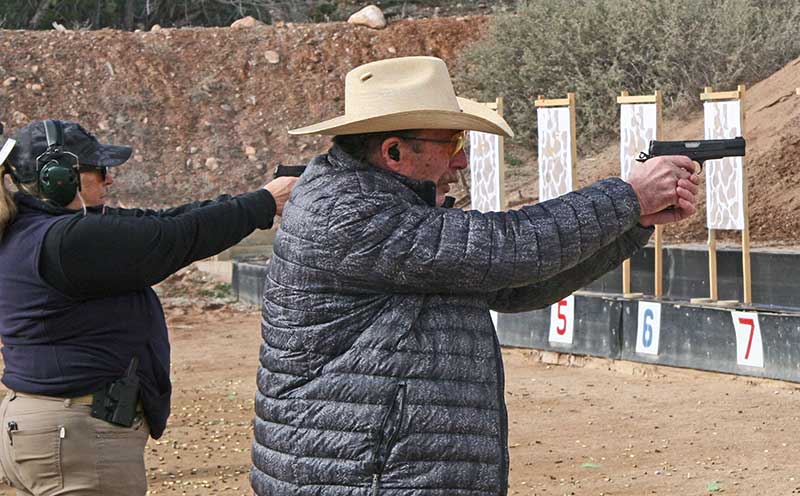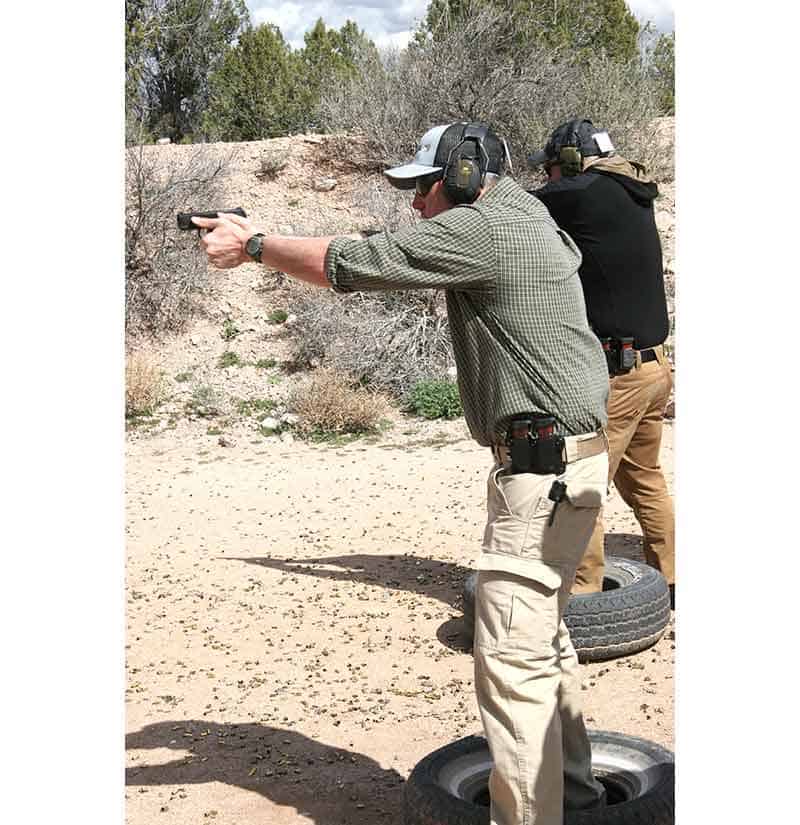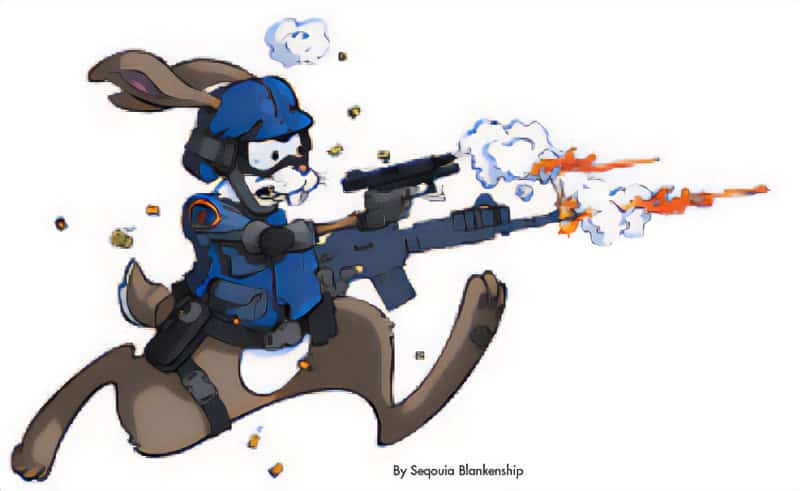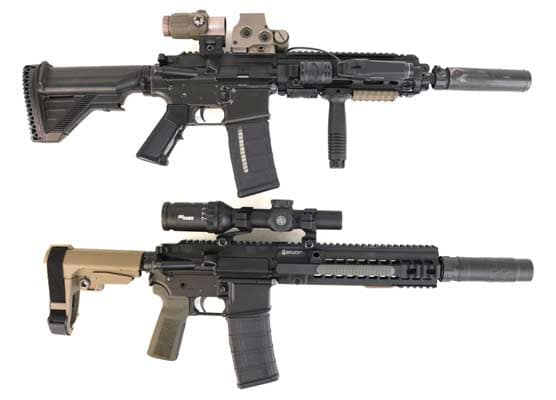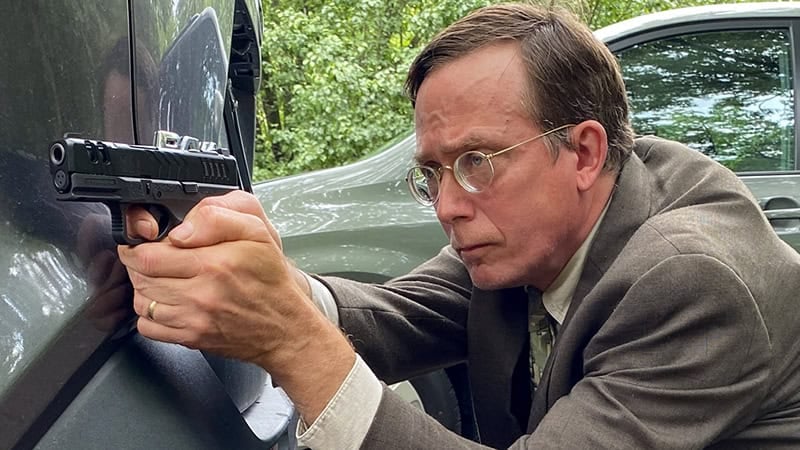Team Tactics class
at Gunsite Academy
A Marriage Encounter Experience —
but with guns!
“A journey of discovery…teaching married couples a simple yet highly effective communication technique…to grow in their marriage through open and honest communication…face-to-face encounter in a comfortable, relaxed setting ….” That’s pretty typical “Marriage Encounter” marketing hype from the internet and while not from Gunsite Academy’s homepage, it fits pretty well as a description of their Team Tactics class my wife and I recently attended.
The class was modified at the suggestion of writer Sheriff Jim Wilson to include members of the shooting press, industry representatives from Mossberg and Federal Ammunition and teams of prior Gunsite graduates such as my wife and myself. According to Jim, team tactics are important because, “It addresses real things that can happen in our lives.”
Car jackings, home invasions, theater and restaurant shootings and other events have brought the threat of armed conflict to the family unit. It’s the domestic couple rather than the infantry squad or SWAT team that may very well find itself in a fire fight and I know of no Pastor, Priest or Rabbi who in-cludes firearms training in their pre-nuptial counseling.
You need not be a fan of Col. Jeff Cooper or Gunsite to appreciate the as-tuteness and veracity delineated in what they’ve titled “The Combat Triad.” It’s depicted as an equilateral triangle comprised of “Marksmanship, Gun-handling and Mindset” with each leg being the equal of the other two in terms of signifi-cance. However, Cooper said in reality, marksmanship is perhaps the easiest of the three virtues to develop. Since most self-defense encounters provide rela-tively uncomplicated marksmanship challenges, shooting skill may actually play a secondary role in surviving an attack.
No two members of a team will possess identical marksmanship skills and it’s critical to know “who’s good at what” when operating as a team. While informal plinking sessions with your team-mate, be they a spousal-unit or co-worker, may be enjoyable, they pale in comparison to firing specific drills under the discipline of Gunsite’s cadre of instructors.
Il Ling New, one of the instructors for our class recommends having a frank discussion with your team-mate and writing a list of each other’s strengths and weaknesses. This knowledge is critical to functioning as a team and can only be discovered on the range in a structured environment. While the shooting drills we ran during the class were skill-enhancing, the real take-away value was the revelation of how my wife’s and my abilities “fit together” as a team.
Mindset
The base of the combat triad is Mindset as it’s the element initiating the functioning of gun handling and marksmanship. Mindset is the awareness to avoid conflict and the will to prevail, not just survive, if conflict is unavoidable. Without a homogenous mindset, team-mates become an inadvertent threat to one another by causing the vigilant to compensate for the inattentive. “Man fights with his mind, his hands and his weapons are simply extensions of his will,” is basic Gunsite doctrine.
Perhaps the most tactile benefit of the Team Tactics class was in the third element of the combat triad — gun-handling. Gun-handling encapsulates every-thing relative to the manipulation of the weapon short of the flash sight picture and compressed, surprise trigger break. Loading, unloading, drawing, re-holstering, moving, holding at ready and covering for your partner are all com-ponents enhancing or endangering a team’s effectiveness in dealing with a threat.
Adding to the “Combat Triad” is the element of communication. Handouts depicting typical hand signals were given as homework to memorize on the first day. On the range, we were expected to talk to our team-mates as we shot. “Gun!” alerted our partner at the beginning of every drawing stroke and “Re-loading,” “Cover,” “Ready” and “Check” were signals we were instructed to use continuously. The challenge of verbal communication in the midst of gunfire is a lesson that doesn’t come from reading a book, it has to be experienced in an environment like Gunsite.
The Funhouse
One of the most enjoyable and memorable facets of any trip to Gunsite is training to clear the funhouse. Having previously experienced it with handguns, carbines and shotguns, this was the first time I ever experienced it with a team-mate. The instruction was done with each team using inert blue guns. The add-ed pressure of not sweeping your partner with the muzzle and knowing which direction to turn when going through a doorway, combined with focusing solely on your area of responsibility versus the entire space, added an element of stress to the exercise I hadn’t felt during previous classes. There’s nothing intui-tive about the coordinated effort required to effectively clear a space with a partner. It requires practice and communication.
For my wife and I the pinnacle event of the class was participating in four “force on force” scenarios utilizing simunitions. Two of the scenarios were con-ducted inside one of the Gunsite funhouses and the other two were outdoor scenarios. It was impressed upon us if we responded correctly and used good communications, there would be no need to fire our guns. What kind of a shoot-ing school teaches you to not shoot?
Jeff Cooper, in one of his early videos on mindset says, “The more compe-tence you feel, both in your weapon and in your degree of competence to han-dle a tactical situation, the less likely you are to shoot.” We felt very lucky to get through three of the four scenarios without firing. The fourth scenario turned into the Wild West. When it was over, Mario Marchman, the instructor running the simulations asked me, “Why didn’t you simply turn around and go back inside the building?” I’m sure my highly refined “deer in the headlights” look told him I was clueless. Forehead slapping epiphanic moments were com-mon in this class — at least for me.
A team’s dynamics are largely driven by the personalities of the partners; therefore, what works for one team won’t necessarily work for another. To ef-fectively administer the class, Charlie McNeese, the Range Master for the class, along with Il Ling New and Mario Marchman had to provide instruction presented not as dogma, but as thought provocation.
Gunsite in general, and Jeff Cooper in particular, are not noted for their So-cratic teaching style. The program, particularly the funhouse and simulation por-tions, seemed to have as much in common with a Dale Carnegie class as they did with a shooting class, and in this case it was very effective.
Going Home
On our drive home from Gunsite, we stopped in a small town in rural New Mexico to refuel. It was a small gas station with two pumps situated in line about 10-12 feet apart. I pulled in behind a car fueling at the lead pump, got out and started fueling from the rear pump. When the car in front of mine pulled out, a pickup pulled around and backed into the space as another car simultane-ously pulled up behind mine, ostensibly to use my gas pump once we were fin-ished.
While not exactly synchronized, their individual movements appeared some-what coordinated and effectively boxed us in. I smiled inwardly when I saw my wife had put down her crossword puzzle having just advanced from Condition Yellow to Condition Orange and was carefully assessing the people both in front and behind us. The comfort of the concealed handgun on my hip was nowhere near as gratifying as the comfort of knowing she and I were on the same page mentally.
My wife’s thoughts are by nature loving, helpful and nurturing. My thoughts tend to gravitate toward guns, ballistics and tactics. We think differently and I’m guessing we’re not all that uncommon. As a couple, getting on the same page in a dangerous world is important, certainly as important as acquiring the latest and greatest whiz-bang armament du jour. Consider a marriage encounter experience at Gunsite like my wife and I did. You’ll find it time well spent.
For more info: www.gunsite.com

Get More Personal Defense Tips!
Sign up for the Personal Defense newsletter here:


